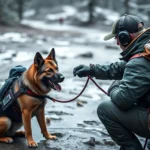
Introduction
Training your dog is one of the most important responsibilities of pet ownership. It not only helps ensure that your dog is well-behaved but also strengthens the bond between you and your furry companion. Modern dog training methods have evolved significantly over the years, moving away from outdated techniques that relied heavily on punishment and dominance. Today, the emphasis is on humane, positive reinforcement approaches that respect the canine mind and foster a loving relationship.
This article will explore the importance of understanding dog behavior, the key principles of modern dog training methods, popular training techniques, essential tools and resources, common mistakes to avoid, and how to maintain training progress. By the end, you’ll have a comprehensive understanding of how to train your dog effectively and compassionately.
Understanding Dog Behavior
The Canine Mind
To train your dog effectively, it’s crucial to understand how dogs think and learn. Dogs are social animals that thrive on interaction with humans and other dogs. They learn best through positive experiences and are highly responsive to emotional cues.
Socialization is a vital aspect of dog behavior. Exposing your dog to different environments, people, and other animals helps them develop confidence and adaptability. This experience is foundational for effective training, as it allows your dog to understand their place in the world.
Common Dog Behaviors
Understanding typical dog behaviors can aid in training. For instance, a wagging tail usually signifies happiness, while growling might indicate discomfort or aggression. Recognizing these signals can help you address issues before they escalate and tailor your training techniques accordingly.
By observing your dog’s behavior, you can create a training plan that aligns with their personality and temperament, ensuring a smoother training process.
Key Principles of Modern Dog Training
Positive Reinforcement
Positive reinforcement is at the heart of modern dog training methods. This technique involves rewarding desired behaviors with treats, praise, or playtime, encouraging your dog to repeat those actions. For example, if your dog sits on command and you reward them immediately, they are more likely to sit again in the future.
The benefits of positive reinforcement over traditional methods are numerous. It nurtures a trusting relationship between you and your dog, reduces anxiety, and promotes a willingness to learn. Unlike punishment-based techniques, which can lead to fear and aggression, positive reinforcement creates a happy learning environment.
Clicker Training
Clicker training is a popular technique that uses a sound (the clicker) to mark the exact moment a desired behavior occurs. This method helps your dog make a clear connection between their action and the reward.
Here’s a step-by-step guide to implementing clicker training:
- Choose a Clicker: Get a clicker that is easy to use and comfortable to hold.
- Introduce the Clicker: Click the device and immediately give your dog a treat. Repeat this several times so your dog associates the sound with a reward.
- Start Training: Once your dog understands the click means a treat, begin training commands (like “sit” or “stay”). Click the moment they perform the desired action, then reward them.
- Practice Consistency: Use the clicker every time they perform the desired behavior to reinforce learning.
With practice, your dog will learn to respond to your commands more readily, making training a rewarding experience for both of you.
Consistency and Timing
Consistency is key in dog training. Use the same commands and cues every time to avoid confusing your dog. For instance, if you choose to use “come” as a recall command, stick with that and avoid variations like “c’mon” or “here.”
Timing is equally critical. Reinforce the behavior immediately after your dog performs it so they can associate the action with the reward. Delayed reinforcement can lead to confusion, making it harder for your dog to understand what behavior you are rewarding.
Building a Strong Bond
Strengthening the bond between you and your dog is essential for effective training. Techniques to enhance this bond include:
- Spending Quality Time: Engage in activities that both you and your dog enjoy, such as walks, playtime, or training sessions.
- Positive Interactions: Use gentle praise and affection to reinforce good behavior, creating a positive atmosphere.
Trust plays a significant role in effective training. When your dog trusts you, they are more likely to respond positively to your commands and are open to learning.
Popular Modern Training Techniques
Obedience Training
Every dog should know basic commands such as “sit,” “stay,” “come,” and “down.” These commands not only enhance safety but also provide a foundation for more advanced training.
Techniques for teaching basic obedience include:
- Using Treats: Reward your dog immediately after they perform the command.
- Being Patient: Allow your dog time to learn and don’t rush the process.
- Practicing Regularly: Consistent practice helps reinforce the commands.
Behavior Modification
Behavior modification involves addressing specific behavioral issues, such as excessive barking or aggression. Techniques for modifying unwanted behaviors include:
- Identifying Triggers: Understand what causes the behavior and address it directly.
- Redirecting: Offer alternatives to the unwanted behavior. For instance, if your dog barks at strangers, redirect their attention with a toy.
- Gradual Exposure: For fearful or aggressive dogs, gradually exposing them to the trigger in controlled settings can help build their confidence.
Specialty Training
Specialty training focuses on specific activities, such as agility, therapy, or service work. The methods vary based on the discipline but generally include:
- Setting Clear Goals: Define what you want to achieve with specialty training.
- Choosing the Right Environment: Practice in settings that mimic the actual activity to help your dog acclimate.
Specialized training not only provides mental stimulation but also strengthens the bond between you and your dog as you work towards common goals.
Training Tools and Resources
Essential Training Tools
Having the right tools can make a significant difference in your training experience. Some essential training tools include:
- Collars and Leashes: Choose a collar that fits well and a leash that offers control.
- Treats: Use high-value treats that your dog loves to keep them motivated.
- Clicker: If you’re using clicker training, invest in a quality clicker.
When selecting training tools, ensure they are comfortable and safe for your dog. Avoid harsh collars or equipment that could cause harm or discomfort.
Online Resources and Communities
The internet is a treasure trove of information and support for dog training. Some recommended online resources include:
- Training Websites: Many professional trainers offer free articles and videos that can guide your training process.
- Forums and Social Media Groups: Joining communities can provide support and encouragement from fellow dog owners.
Sharing experiences and learning from others can enhance your training journey.
Professional Training Options
While many dog owners successfully train their pets at home, sometimes professional help is beneficial. Consider hiring a professional trainer if:
- You’re struggling with specific behavioral issues.
- You want to learn advanced techniques.
- You prefer structured training classes.
Types of training classes available include group obedience classes, private lessons, and specialty training sessions tailored to specific needs.
Common Mistakes in Dog Training
Miscommunication
One of the most common mistakes in dog training is miscommunication. Inconsistent commands or unclear cues can confuse your dog and hinder their progress. Ensure everyone in your household uses the same commands and techniques to avoid mixed signals.
Inconsistency
Inconsistent training methods can lead to frustration for both you and your dog. If you allow certain behaviors sometimes but not others, your dog will struggle to understand what is expected. Aim for consistency in your training approach.
Neglecting Socialization
Socialization is a critical aspect of dog training that is often overlooked. Failing to expose your dog to different environments, people, and other animals can lead to fear and behavioral issues. Make socialization a priority during your training process.
Using Punishment
Punishment-based training methods are discouraged in modern dog training methods. These techniques can cause fear and anxiety, leading to further behavioral problems. Instead, focus on positive reinforcement and redirection to encourage desired behaviors.
Maintaining Training Progress
Reinforcement of Learned Behaviors
Once your dog has learned a command, it’s essential to reinforce that behavior regularly. Techniques for reinforcement include:
- Random Rewards: Occasionally reward your dog for following commands without prompting to keep them engaged.
- Gradual Fading: Over time, reduce the frequency of treats while maintaining verbal praise.
Continuous Learning
Training should never stop. Continuous learning helps keep your dog mentally stimulated and reinforces their training. Engage in new activities, teach advanced commands, or try different training techniques to keep things fresh.
Adapting to Changes
As your dog ages or as circumstances change, you may need to adjust your training methods. Be flexible and willing to adapt your approach to suit your dog’s needs and abilities, ensuring their continued success in training.
Conclusion
In conclusion, embracing modern dog training methods can significantly enhance your relationship with your dog. By focusing on positive reinforcement, understanding canine behavior, and employing effective training techniques, you can foster a loving and respectful bond with your furry friend.
Training is not only about teaching commands; it’s about building trust and companionship. As you embark on this journey, remember to enjoy the process and celebrate the small victories along the way. The joy of training and the bond it creates between you and your dog is truly rewarding.
Call to Action
We invite you to share your training experiences and insights! Join our community by subscribing to our newsletter or following us on social media for more tips and valuable information on dog training.









